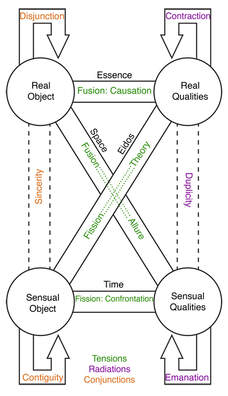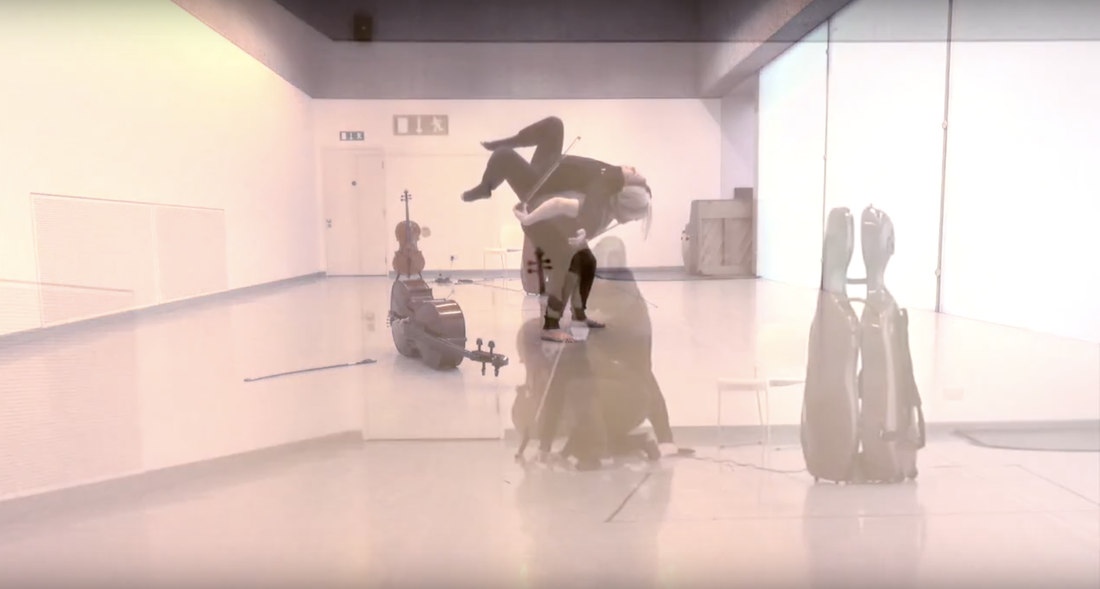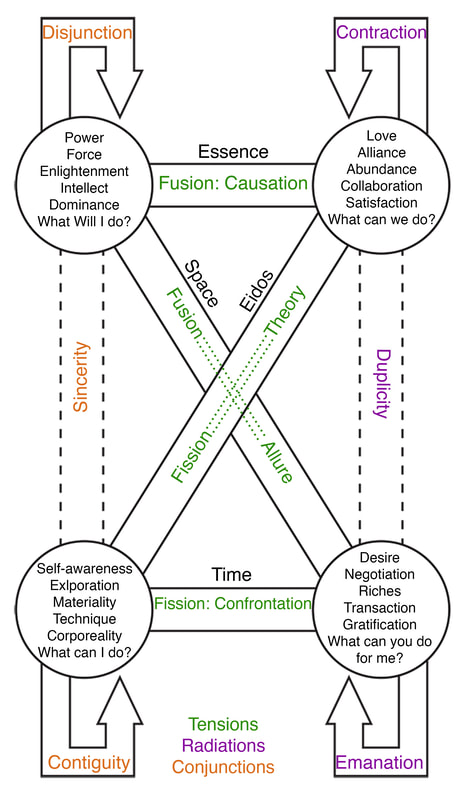Where Does a Body End?
Where Does a Body End? is a collaboration between me and Irene Fiordilino. What we aim to do in this work is to move beyond the traditional paradigms of music-dance collaboration into a situation in which our practices become entangled and we enter into a relation which I describe as being, rather than cross- or inter-disciplinary, as transdisciplinary: the expert techniques we each bring into the work are not used as avatars of our own individual expertise but serve to transform and support the others' actions as we blur the boundaries of what we do. My sounding practice becomes reconsidered as a movement practice, and Irene's moving practice likewise becomes considered in terms of sound - both in material terms of actual sound or movement being produced, but also in how we perceive and conceive the world, in contradistinction to the visual paradigms that are dominant in how we usually encounter the world.
Below you can read about the inspirations for this project, and if you've been to a sharing or performance of it you can leave comments/feedback about it in the form at the bottom of this page.
Below you can read about the inspirations for this project, and if you've been to a sharing or performance of it you can leave comments/feedback about it in the form at the bottom of this page.
ORIGINS
The origins of this project go back to my experiences in the Covid-19 pandemic and living in lockdown. As ell as the sudden disruption and removal of the ability to perform live, there were also stresses on the body - the mental strain of remote working, but also the physical problems I developed as a resuklt of greatly reduced physical movement. When the restrictions eased and public live performance became possible again, I found myself thinking about the very basics of my activity as a cellist: a renewed focus on the physical, material reality of the actions of playing, and also by considering my damaged and healing body, the realtionship between me and my instrument. In this I was influenced by writings of Ben Spatz and Jane Bennett on the materiality of human and non-human bodies.
I had also been reading about Object Oriented Ontology (OOO), the philosophical movement spearheaded by Graham Harman and Timothy Morton, and in particular Harman's concept of the Quadruple Object and Morton's idea of the Hyperobject. While I'm naturally a sceptic and reluctant to sign up to any kind of movement, I found these ideas useful in beginning to conceive the present project.
The origins of this project go back to my experiences in the Covid-19 pandemic and living in lockdown. As ell as the sudden disruption and removal of the ability to perform live, there were also stresses on the body - the mental strain of remote working, but also the physical problems I developed as a resuklt of greatly reduced physical movement. When the restrictions eased and public live performance became possible again, I found myself thinking about the very basics of my activity as a cellist: a renewed focus on the physical, material reality of the actions of playing, and also by considering my damaged and healing body, the realtionship between me and my instrument. In this I was influenced by writings of Ben Spatz and Jane Bennett on the materiality of human and non-human bodies.
I had also been reading about Object Oriented Ontology (OOO), the philosophical movement spearheaded by Graham Harman and Timothy Morton, and in particular Harman's concept of the Quadruple Object and Morton's idea of the Hyperobject. While I'm naturally a sceptic and reluctant to sign up to any kind of movement, I found these ideas useful in beginning to conceive the present project.
THE QUADRUPLE OBJECT

Harman's quadruple (or fourfold) object is a concept that has its roots in Heidegger's observation that real objects always withdraw from our perception: if I hold a hammer in my hand, the only knowledge I have of it directly is via my own perceptive mechanisms and my conceptual ideas of what a hammer is - the actual hammer is inaccessible to me. Heidegger also talks of the object-at-hand: when I am using the hammer its reality withdraws from me, and I only really become conscious of its hammerish identity if it breaks and becomes unusable.
Harman expands this idea into four aspects of an object: the "Real" object, which is not dirctly acessible, its "Real" Qualities, the "Sensual" object - the object as I encounter it - and its "Sensual" qualities as I encounter them. The pathways between these four points form a network of attractions and tensions.
This structure forms the basis of our work and acts as a kind of map to guide how we move through the area of action and how our interrelations change as we do.
There are four bodies in this work: our own two human bodies, the body of my cello, which sits in the position of the Real Object and therefore is never physically drawn into the action, only present as part of the atmophere, and a second cello which fully physically interacts with the two human bodies.
Harman expands this idea into four aspects of an object: the "Real" object, which is not dirctly acessible, its "Real" Qualities, the "Sensual" object - the object as I encounter it - and its "Sensual" qualities as I encounter them. The pathways between these four points form a network of attractions and tensions.
This structure forms the basis of our work and acts as a kind of map to guide how we move through the area of action and how our interrelations change as we do.
There are four bodies in this work: our own two human bodies, the body of my cello, which sits in the position of the Real Object and therefore is never physically drawn into the action, only present as part of the atmophere, and a second cello which fully physically interacts with the two human bodies.


